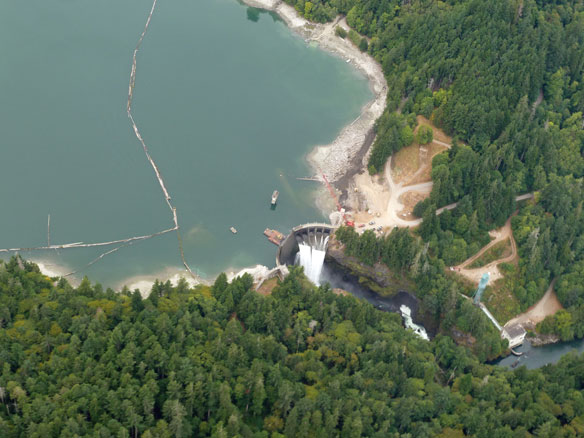
Elwha Dam removal, 2011. The largest dam-removal project in U.S. history—the Elwha River Restoration Project—commenced during the second week of September 2011, when National Park Service contractors began to dismantle two dams on the Elwha River in Washington State. The 32-m-tall Elwha Dam and the 64-m-tall Glines Canyon Dam, completed in 1913 and 1927, respectively, have been blocking the natural supply of sediment to the lower river and coast and severely limiting salmon and steelhead spawning for nearly a century. Captions: Jonathan A. Warrick / USGS. Photograph: © SAF
By USGS;
More than 1,000 dams have been removed across the United States because of safety concerns, sediment buildup, inefficiency or having otherwise outlived usefulness. A paper published in Science finds that rivers are resilient and respond relatively quickly after a dam is removed.
“The apparent success of dam removal as a means of river restoration is reflected in the increasing number of dams coming down, more than 1,000 in the last 40 years,” said lead author of the study Jim O’Connor, geologist with the U.S. Geological Survey. “Rivers quickly erode sediment accumulated in former reservoirs and redistribute it downstream, commonly returning the river to conditions similar to those prior to impoundment.”
Dam removal and the resulting river ecosystem restoration is being studied by scientists from several universities and government agencies, including the USGS and U.S. Forest Service, as part of a national effort to document the effects of removing dams. Studies show that most river channels stabilize within months or years, not decades, particularly when dams are removed rapidly.
“In many cases, fish and other biological aspects of river ecosystems also respond quickly to dam removal,” said co-author of the study Jeff Duda, an ecologist with USGS. “When given the chance, salmon and other migratory fish will move upstream and utilize newly opened habitat.”
The increase in the number of dam removals, both nationally and internationally, has spurred the effort to understand the consequences and help guide future dam removals.
“As existing dams age and outlive usefulness, dam removal is becoming more common, particularly where it can benefit riverine ecosystems,” said Gordon Grant, Forest Service hydrologist. “But it can be a complicated decision with significant economic and ecologic consequences. Better understanding of outcomes enables better decisions about which dams might be good candidates for removal and what the river might look like as a result.”
Sponsored by the USGS John Wesley Powell Center for Analysis and Synthesis, a working group of 22 scientists compiled a database of research and studies involving more than 125 dam removals. Researchers have determined common patterns and controls affecting how rivers and their ecosystems respond to dam removal. Important factors include the size of the dam, the volume and type of sediment accumulated in the reservoir, and overall watershed characteristics and history.
1000 dams down and counting, Science
Movement to Take Down Thousands of Dams Goes Mainstream, National Geographic (01-29-2015)
Elwha, The Grand Experiment (11-12-2012)
Largest Dam Removal in U.S. History Scientifically Characterized: A USGS Lecture on Largest U.S. Dam Removal; USGS (02-25-2015)
Scientists worked together to characterize the effects of the largest dam removal project in U.S. history occurring on the Elwha River of Washington State. New findings suggest that dam removal can change landscape features of river and coasts, which have ecological implications downstream of former dam sites…
Tracking Sediments’ Fate In Largest-Ever Dam Removal, University Of Washington (03-08-2013)
Scientists tracking the aftermath of the largest dam removal in U.S. history say the dismantling of a dam in northwestern Washington state has unleashed about 34 million cubic yards of sediment and debris that built up for more than a century…
On The Elwha, A New Life When The Dam Breaks
Nobody figured the largest dam removal project ever attempted in the U.S. was going to be easy, or fast.The nation’s largest and most ambitious dam removal will begin this month, when workers start demolishing two antique dams on Washington state’s Elwha River…
“River Reborn: Elwha Flows Wild and Free Once Again,” NBC News
A construction crew on Tuesday detonated a large charge of dynamite, destroying the last remaining portion of Glines Canyon Dam and hastening the restoration of the Elwha River in the far reaches of the Pacific Northwest.
Dams – Cutting off our Beach Sand; By Gary Griggs (12-19-2014)
New Global Warming Culprit: Dams
Washington State University researchers have documented an underappreciated suite of players in global warming: dams, the water reservoirs behind them, and surges of greenhouse gases as water levels go up and down.








